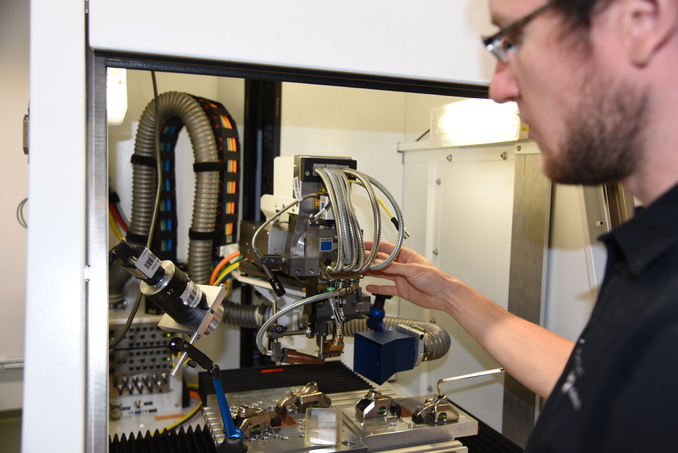The Green Light for Aalen UniversityCutting edge laser source for electromobility and 3D-printing
At the Laser Application Centre of Aalen University, further construction of the equipment fleet and the associated opportunities push forward. Already in this year, research equipment valuing nearly 2 million Euros have been put to work. The newest addition is a high-powered laser system with green wavelengths. With these wavelengths, reflective metals like copper can also be processed, compared to conventional infrared lasers. This opens opportunities to investigate new research questions in the area of electromobility and additive manufacturing, together with regional companies.
„We are ready for the inauguration of the new research building in November,“ says Professor Harald Riegel excitedly, who put together the Laser Application Centre (LAZ) in the past years. The LAZ will promptly put the new green laser source TruDisk 1020 from the company TRUMPF to use in the Centre of Sustainable Technologies (ZTN). In the ZTN, various groups are research topics at Aalen University like sustainable mobility, renewable energies and resource efficiency. Highly demanded key technologies are central in the region, including production technologies and material innovation, lightweight design as well as optical technologies.
The New System is Versatile
The Laser Application Centre specialized in laser processing techniques. “The new laser, which was funded through the device program of the Ministry of Science, Research and Art, will especially improve our activities in sustainable laser welding. Here, we’re planning projects for long-lasting connections in raw materials like copper alloys or aluminum. On top of that, we want to research using new materials like magnetic materials and hard metals for additive manufacturing”, says Jochen Schanz, doctoral candidate at the LAZ.
The cooperation partners of the LAZ should also benefit from the new system. In this regard, the university has several successful collaborative research activities with the professors Rainer Börret and Andreas Heinrich from the Centre for Optical Technologies (ZOT), as well as the professors Gerhard Schneider, Volker Knoblauch and Dagmar Goll from the Institute for Material Research (IMFAA). Further projects with companies in the region will also be planned.
The Challenge of Reflective Materials
Processing copper alloys with lasers is very challenging, as a large portion of the laser waves and the corresponding energy are reflected. Even the smallest surfaces and material fluctuations have a strong influence and destabilize the welding process. In contrast, visible laser waves like the green laser light are absorbed by copper ten times better. Through this method, processing copper can be executed more reliably and regardless of the surface condition. Possible places for application include stators in electric motors, in which several copper wires, so-called “hairpins”, are available. The green laser with a strength of 1 kilowatt is at a processing station called “TruLaser Station 5005” at the company TRUMPF, and integrated with axle movement in five directions. In this way, even contours in complex components can be reached, and the finest welding assignments completed. Due to the high quality of the beams, they can be focused to a diameter of 50 µm, allowing for even the finest contact on circuit boards.

